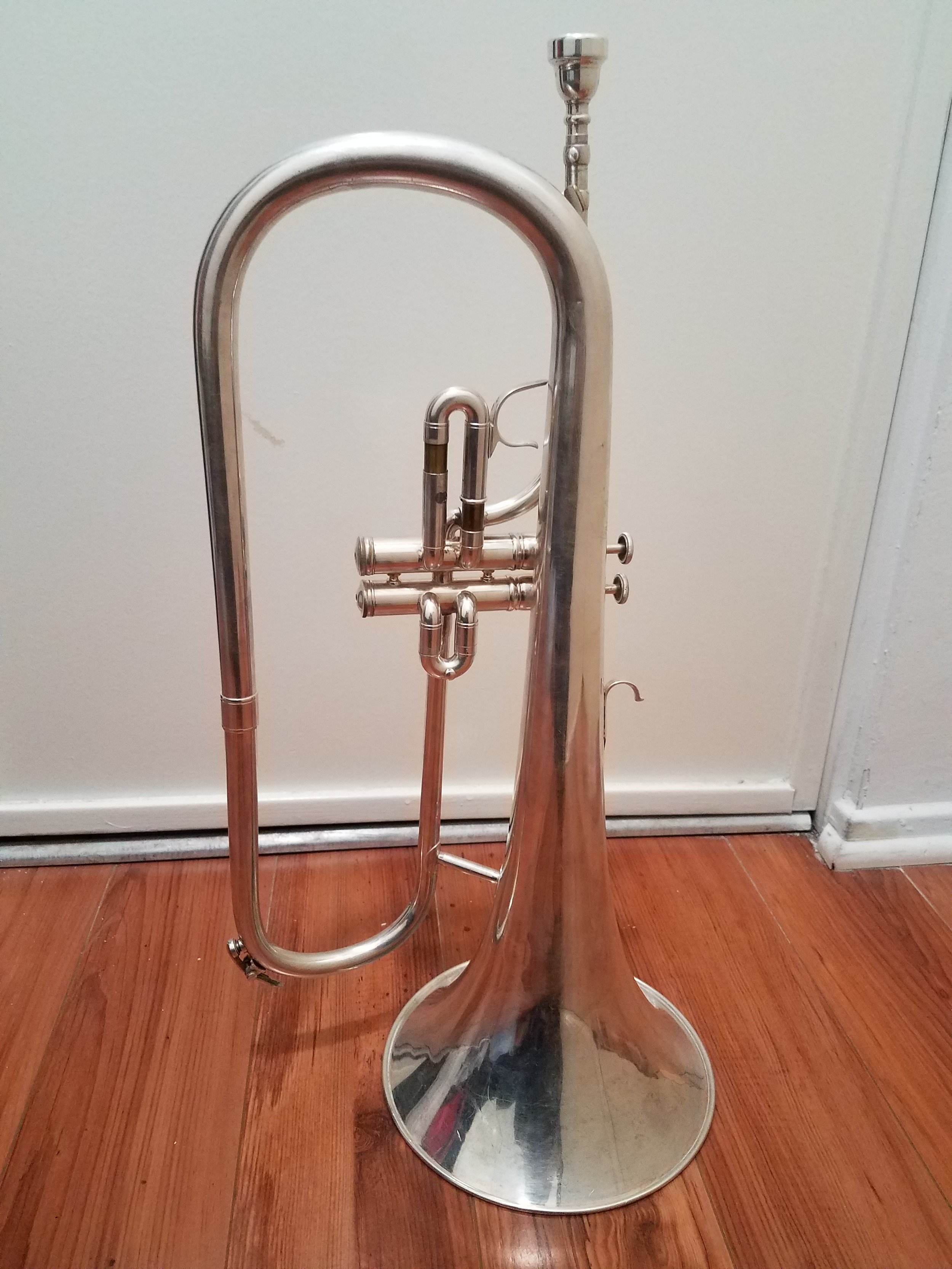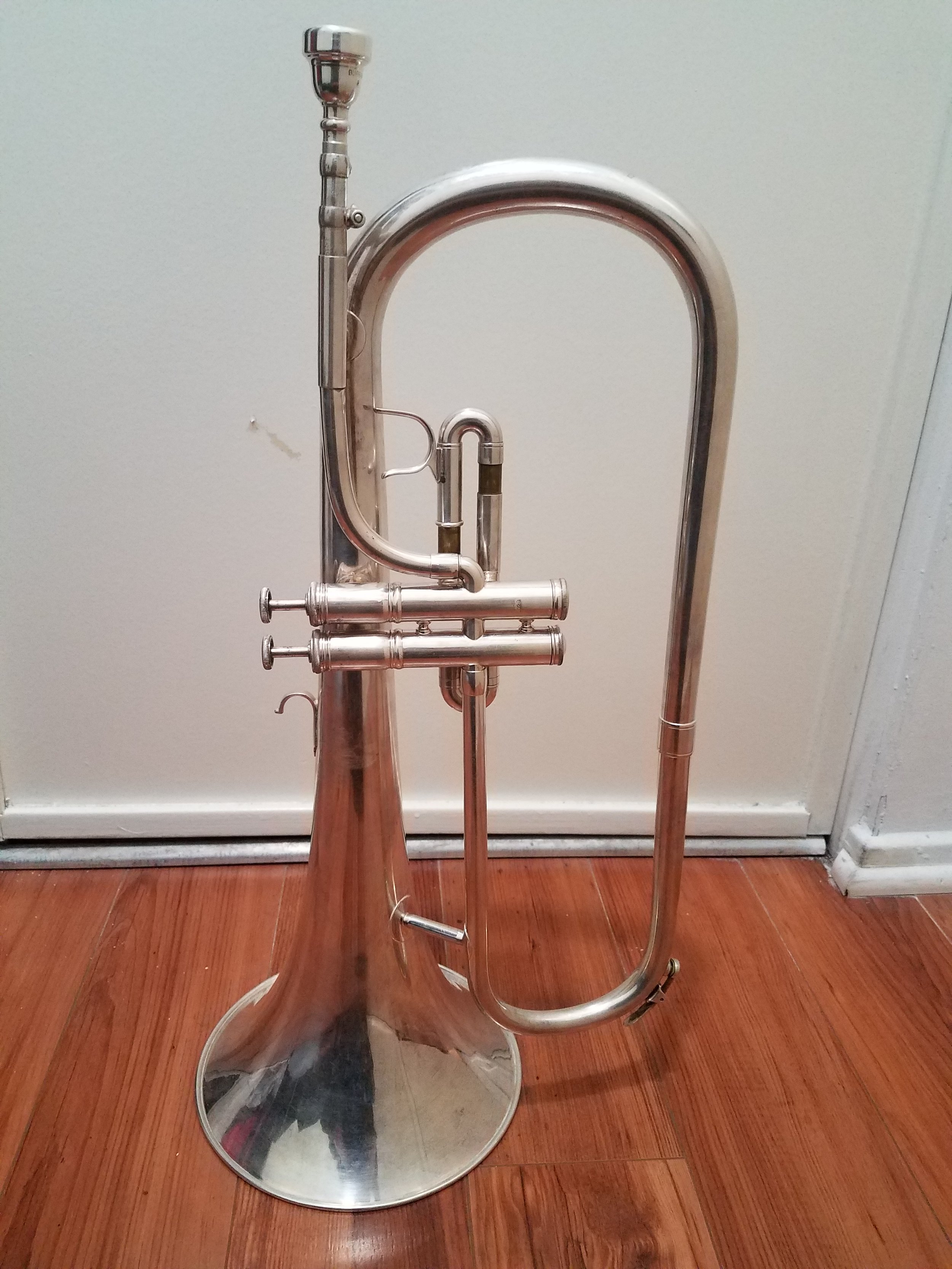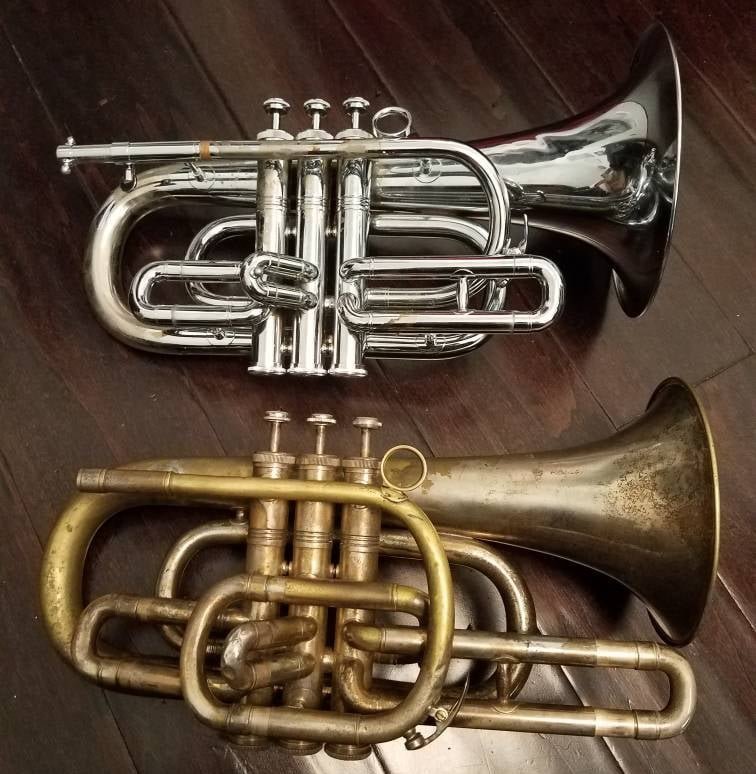Brass instrument mutes are amazing tools and are lots of fun, but can be daunting for a new player or a composer to dive into. There are so many different kinds out there. If you’ve ever asked yourself “what mutes do I need?” or “what mutes can I write for?”, or if you’re just curious about mutes in general, you’re in the right place.
MUTE TYPES
Straight
The straight mute is by far the most commonly used mute in band and orchestra music, and is what you use when the part simply says “mute” or “con sord.” without any further description. In jazz it is less common than cup, Harmon, or plunger, but still good to have around for the Swing Era or David Baker charts that call for it. The modern default is a metal (usually aluminum) straight mute, but fiber and wooden straight mutes are also used in certain circumstances. In general, metal mutes sound the brightest, wooden mutes the darkest, and fiber somewhere in the middle. They are all noticeably different sounds, and occasionally a composer will specify the material of straight mute desired. Most of the time however, brass players will choose what straight mute to use on their own. It is common for trumpet players especially to own a few different straight mutes for different purposes.
The three most popular brands of metal straight mute for trumpets and trombones are Jo-Ral, Denis Wick, and Tom Crown. Any are good choices, but I tend to favor the Jo-Ral. Tom Crowns sound great but do not have a felt ring on the small end, making it much easier to put dents in your bell, and make a racket while doing so. Of course, those three brands are far from the only metal straight mutes out there. I have a Humes & Berg aluminum trombone straight mute that is wonderful, especially considering H&B is not really known for its metal mutes!
If you are a freelance trumpet or trombone player, it is a good idea to eventually pick up a Humes & Berg Stonelined fiber straight mute. Like its cup mute sibling, the H&B has a unique sound that is sometimes desirable in jazz. Nowadays it’s not nearly as common to need one as it once was, as metal straight mutes have become the accepted default even in jazz. That said, I have needed my H&B on few gigs, including one where the bandleader explicitly called for “Stonelined straight mute” in the part. Plus, they are very inexpensive so it won’t set you back that much to get one.
In the French horn world, the straight mute is the only mute ever called for. Unlike with trumpets or trombones, horn players typically always use wooden mutes as they match the instrument far better than the other types (though fiber and metal horn mutes do exist). Ion Balu makes a fabulous horn mute, but there are a few others (Marcus Bonna for example).
Cup
Cup mutes are the most common mute in big band jazz, and are the second most common (but a distant second) elsewhere. In jazz, the classic red and white Humes & Berg Stonelined fiber cup mute is the default, and nearly always the desired sound. Any jazz brass player absolutely must own a Stonelined cup mute.
While still ubiquitous in jazz for its unique sound, the H&B Stonelined is outdated (and can even be seen as amateurish) in the classical realm. In orchestra and band, the standard is the Denis Wick adjustable cup mute. This mute is a mixture of metal and fiber, and the cup can be removed to give a passable fiber straight mute. As any working classical trumpet or trombone player will have a Denis Wick cup mute on hand, writing for and specifying fiber straight mute is a safe bet. Additionally, as the Wick is an adjustable cup, writing for “tight cup” and other specific settings is also safe. Markings for “tight cup” do appear from time to time in jazz and Broadway shows, so jazz and commercial players will often carry a Wick adjustable cup in addition to their Stonelined. The Wick cup is not the only adjustable cup out there, and a player may prefer a different brand. But even if you use a different adjustable cup when you are the only player on your instrument, you should also have a Wick to match with a section. Matching mutes is advisable whenever possible.
There are cup mutes (as well as bucket mutes) for French horn, euphonium, tuba, and even British tenor horn and baritone horn. However, these are very rare and almost never called for, so it is best to avoid writing for them unless you are writing for a specific player or ensemble that has them. Similarly, as a player you will never show up to a gig with “cup mute” written on your euphonium part unless you play in a high-level British brass band that probably owns their own set, so you don’t need to buy one unless you want to. (And I don’t blame you for that…they sound extremely cool!)
Plunger
The humblest of mutes. There are plenty of specialty “plunger mutes” out there made of metal, fiber, or rubber, but the best plungers are still the bendy red ones from a hardware store. This also means they cost literally a dollar or two, so no player of a bell-front brass instrument should ever be without one. If you are playing Ellington and similar older big band music, you may need a pixie mute (typically an H&B Stonelined) to compliment your plunger.
Harmon
The Harmon mute is so named (with a capital “H”) because the original comes from the Harmon brand. Also called a “wah-wah” mute, the Harmon has a very unique sound with or without the stem. (As a composer, when writing for Harmon you should always specify “Harmon mute - stem in” or “Harmon mute - stem out” in the part. Or even “stem extended” if you’re really daring!) Although there are Harmon mutes for trombone and bass trombone, they are used very rarely. They sound very different from the trumpet Harmon, which is extremely common in jazz.
In jazz, the Harmon is almost never used with the stem, so much so that big band charts often don’t specify stem in or out - it is always assumed the stem is out. You can find stem in or out in Broadway shows, and in the rare occasions when Harmon is called for in classical music, it is usually with the stem in. There are quite a few trumpet Harmon mutes out there, including the original Harmon B Model. The Jo-Ral “bubble mute” Harmon is likely the most popular, and plays easier than the original Harmon. Jo-Ral also makes a bubble mute for flugelhorn! Needless to say, it is very unnecessary like all flugelhorn mutes…but it is very cool regardless.
For composers, writing for trumpet Harmon is normal in jazz, and fairly safe in band or orchestra. It is a standard mute in the trumpeter’s quiver, and only trumpet players who ONLY play classical might not own one. Writing for trombone Harmon is more risky, as many trombone players don’t have one. But plenty of contemporary orchestral and trombone choir music has made extensive use of trombone Harmons, so there is certainly precedent for it.
Bucket
The bucket mute is an interesting beast. Much like the cup mute, the Humes & Berg Stonelined bucket (called the Velvet-Tone) is still desirable in jazz for the sound. However, the Velvet-Tone is by far the most cumbersome and time-consuming bucket mute to attach and remove. This is not good for things like Broadway parts which are littered with notoriously quick mute changes, so trumpeters and trombonists usually start with a quicker bucket mute like the Jo-Ral and pick up an H&B later. The reason for having both is that the Jo-Ral bucket especially sounds VERY different from the H&B. This effect is most pronounced on trumpet, but present on trombone as well. The Jo-Ral bucket sound can be desirable (Wynton Marsalis often uses one when soloing), but it is generally not the desired sound for jazz section work.
Solo-Tone
In my opinion one of the coolest mutes out there, the solo-tone makes you sound like you’re playing through an old Gramophone. It is an acoustic “lo-fi” mute! However, it is also mostly absent from a trumpet or trombone player’s needs; the one place where Solo-Tone is frequently called for is Broadway, so if you play a lot of musical pit gigs, you’ll need to pick one up. It is generally a mute that brass players will not own otherwise, but I think more people should as it’s a lovely sound. The original Solo-Tone mute was made by Shastock and original ones are rare and fetch high prices, so most players use a new production mute made by one of a few brands such as Humes & Berg, Emo, TrumCor, Walt Johnson, and Warburton. If you don’t have a Solo-Tone mute and a part that calls for one lands on your stand (which can be marked “Solo-Tone” or “wood mute” in shows), use a Harmon mute with the stem in as a substitute.
Practice
Practice mutes are designed to make your sound as quiet as possible, so you can practice in places you otherwise would be too loud to play in (hotels, apartments, warming up backstage, etc.). There are a ton of practice mutes out there, and which one is best comes down to personal preference. They are not intended to be performance mutes, and don’t give a pleasing tone quality to be used as one in my opinion. Still, that hasn’t stopped some contemporary composers from writing for practice mutes in their brass parts. Practice mutes range from expensive and clever mutes like the Yamaha Silent Brass series, to DIY practice mutes made from a $2 Renuzit air freshener. I have both and several in between, and they all have their place. If you’re looking for a cheap practice mute (that isn’t made from an air freshener), I use and heartily recommend the Pampet practice mutes from Amazon. They are very affordable at $19 (trumpet) and $20 (trombone), and I prefer them over many much more expensive practice mutes.
Whisper
Whisper mutes are rare. Few manufacturers make them (Bremner and Emo are the two I know of) and not much is written about them. They are essentially practice mutes adjusted to be legitimate performance mutes that are louder and have better tone quality than a real practice mute, but can also be used as a practice mute in a pinch. I have never seen a whisper mute explicitly specified in a part, but it’s probably out there.
Buzz
Originally a model from Humes & Berg called the “Buzz-Wow” that is now very rare, the buzz mute essentially makes your instrument sound like a kazoo. Hirschman currently makes a buzz mute for trumpet and trombone called the Chicago Stinger, and you can get buzzers on Huber’s straight and pixie trumpet mutes. Daniel Schnyder’s subZERO bass trombone concerto calls for one, and performers of the piece have made their own using an old cone-shaped mute and a few kazoos. The legendary vintage trombone guru DJ Kennedy also made a few in a similar way.
Derby
Also called a “hat mute”, this kind of mute was originally an actual derby hat hung from the music stand or manually operated like a plunger. Nowadays players usually use actual derby mutes designed for the purpose, but apart from period jazz ensembles it is rare today for hat mutes to be used. Typically “in hat” instructions are ignored or faked by simply pointing the bell into the music stand. Although hats show up quite often in Swing Era big band charts, owning your own derby mute is not very common.
Others
While the above mutes cover anything you could possibly be asked to play, there are a few other types of mutes out there. These include the Emo megaphone mute, the Humes & Berg Stonelined 127 satellite mute, and a few custom homemade mutes. The aforementioned DJ Kennedy had a few trombone mutes made out of trumpet bells (“Trump-O-Tone”) and clarinet bells (“Clari-Tone”) that offer a unique sound. I own a Clari-Tone that I bought from DJ, and it sounds like a cross between a straight mute and bucket mute.
FIRST MUTES
If you are just starting your mute collection, these are the types of mutes I’d recommend.
Trumpet (band/orchestra): Jo-Ral aluminum straight mute, Denis Wick adjustable cup mute
Trumpet (jazz): Humes & Berg Stonelined cup mute, Jo-Ral bubble mute, hardware store 4” sink plunger
French Horn: Ion Balu or Marcus Bonna wooden straight mute
Trombone (band/orchestra): Jo-Ral aluminum straight mute, Denis Wick adjustable cup mute
Trombone (jazz): Humes & Berg Stonelined cup mute, hardware store toilet plunger
Bass Trombone (band/orchestra): Jo-Ral aluminum straight mute, Denis Wick adjustable cup mute
Bass Trombone (jazz): Humes & Berg Stonelined 199 Mic-A-Mute, hardware store toilet plunger
Euphonium: Denis Wick aluminum straight mute
Tuba: Denis Wick aluminum straight mute
ESSENTIAL CAREER MUTES
These are the mutes essential for any gigging freelance brass player. My brand recommendations are in parentheses.
Trumpet: metal straight (Jo-Ral), fiber straight (TrumCor), fiber cup (Humes & Berg Stonelined), adjustable cup (Denis Wick), Harmon (Jo-Ral), plunger (4” hardware store), bucket (Humes & Berg Stonelined Velvet-Tone), solo-tone (Shastock or Humes & Berg Stonelined Clear-Tone)
French Horn: wooden straight mute (Ion Balu or Marcus Bonna), stop mute (Tom Crown)
Trombone/Bass Trombone: metal straight (Jo-Ral), fiber cup (Humes & Berg Stonelined), adjustable cup (Denis Wick), plunger (hardware store), bucket (Humes & Berg Stonelined Velvet-Tone AND a quicker one, such as Jo-Ral)
Euphonium: straight (Ion Balu)
Tuba: straight (Schlipf)
MUTE COMPATIBILITY
If you’re into weird brass instruments as much as I am, you’ve probably thought about using them with mutes. Here are all the compatibilities I’ve found.
Bass Trumpet: small trombone or flugelhorn mutes (which one works better depends on the model)
DEG Alto Cornet: flugelhorn mutes
Dynasty G Soprano Bugle: NOT most trumpet mutes (throat is too large!)
Getzen Frumpet: bass trombone mutes
Flugabone: small trombone mutes
Kanstul G Alto Bugle: large trombone mutes
Marching Mellophone: tenor or bass trombone mutes, depending on the specific mute
Mellophonium: tenor or bass trombone mutes, depending on the specific mute (except plunger and wa-wa effects on a Harmon, because the reach is too far)
Soprano Trombone: some trumpet mutes
MUTE RECIPES
Oboe substitute: trumpet (C or E-flat) with wood or fiber straight mute
English horn substitute: flugelhorn with cup mute or trumpet (B-flat) with dark-sounding cup mute
Bassoon substitute: trombone, bass trombone, or flugabone/valve trombone (depending on passage) with cup mute
Clarinet substitute: trumpet with bucket mute (ideally wood)
MUTE MANUFACTURERS
aS
Bach
Best Brass
Beversdorf (rare vintage metal straight mutes for tenor and bass trombone, with the darkest sound of any metal straight mute I’ve heard)
Brass Spa
Bremner/sshhmute (practice mutes and a whisper mute)
Care for Winds
Charles Davis
Clary Woodmutes (wooden trumpet mutes)
DEM-BRO
Denis Wick
Eazy Bucket (H&B-style bucket mutes that are easier to attach/remove)
Emo (a wide range of affordable plastic mutes)
Engemann (traditional wooden mutes)
Facet (unique wooden mutes)
Faxx
Harmon
Hawkins
Hickman
Hirschman (buzz mutes and plunger mutes)
Horn-Crafts Mutes
Huber Mutes
Humes & Berg (creators of both the iconic Stonelined red-and-white fiber mutes and a line of “Symphonic” aluminum mutes)
Ion Balu (wooden mutes)
Ira Nepus (innovative Softone rubber mute that can be a bucket or practice mute)
Jo-Ral (originally Alessi-Vacchiano)
Marcus Bonna
MG Leather Work
Michael Rath (metal trombone and bass trombone mutes)
Mike McLean (a full range of fiberglass mutes for all British brass band instruments)
Mutec
Okura+mute
On-Stage
Pampet (affordable practice mutes)
Peter Gane
P&H
Pöltl (Esser Dämpferbau)
Powerstopf (French horn stop mute)
Pro Line (light fiber mutes)
ProTec
Ray Robinson (a vintage mute maker with highly desirable fiber jazz mutes)
Rejano (trombone practice mutes)
RGC Mutes
Schlipf (tuba mutes)
Shastock (makers of the original Solo-Tone)
Soulo
Thomann
Tools 4 Winds
Tom Crown
Trapani (a new high-quality 3D-printed mute company)
TrumCor (high-quality black fiber mutes used frequently by orchestral trumpeters)
Ullvén
Upmute
Vhizzper (practice mutes)
Voigt Brass
Wallace (a full range of metal mutes)
Walt Johnson
Warburton
Windy City
Yamaha (mostly known for the Silent Brass practice mutes, though they do make other kinds of mutes as well)









































